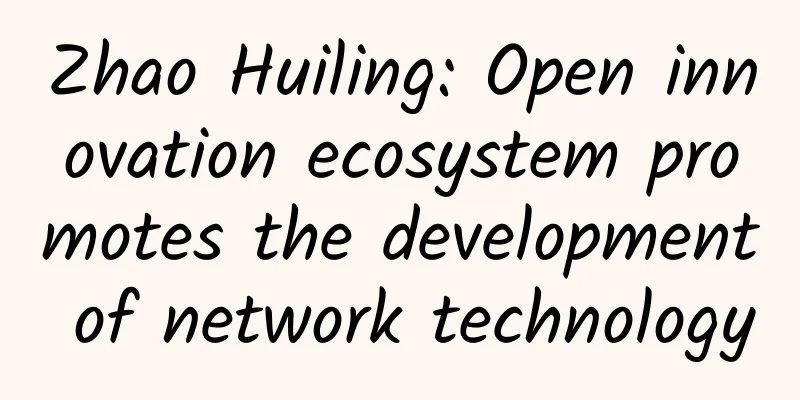Zhao Huiling: Open innovation ecosystem promotes the development of network technology

|
At the theme forum "Future Network Technology Development and Transformation" of the 5th Future Network Development Conference, Zhao Huiling, director of the China Communications Society and chairman of the Information Network Technology Professional Committee, shared with everyone "Open Innovation Ecosystem Promotes Network Technology Development."
We have been discussing the development of the future network and what the network will look like in 2035? Academician Yu Shaohua summarized a TRUST principle (T: Tb/s bandwidth, R: ultra-high reliability, U: ubiquitous connection, S: sub-millisecond latency, T: terahertz spectrum) to look forward to the future. Under the new situation, the overall development of the network includes extreme performance, elastic reconfiguration, multi-resource integration, ubiquitous connection, autonomous management, endogenous security, and green and low-carbon technology features. Under the characteristics of such a large future network, the current development strategy of data development, computing power development and cloud-network integration requires very high computing capabilities. Digital development has brought about an explosive growth in information data, and massive data needs to be stored and aggregated and analyzed in the cloud or edge to realize data value transformation. However, ubiquitous computing power presents characteristics such as multi-level, decentralized, and disordered. It is difficult to achieve unified coordination between computing power and the network, and the intelligent on-demand capability of computing power requires network adaptation. The computing network will become the basic supporting architecture for cloud-network integration. Operators used to only provide connectivity, but now they need to provide computing, storage, and even security capabilities in the network as a service. This is actually an expansion of capabilities and services. The standardization of computing networks has been carried out in an orderly manner in major standard organizations at home and abroad. The research on computing networks is also an important part of the future network field and even the expansion of network capabilities. Now with the development of edge computing, the original form of traditional communication network equipment has changed, and new forms of network equipment have emerged, such as edge Leaf white boxes, fixed-mobile convergence, UPF equipment forms and modularization, which can flexibly customize edge networks, reduce edge deployment costs, and improve programmability. Regarding the protocols in the IP network field, the entire IP protocol can be improved from three dimensions: technical capabilities, security capabilities, and application capabilities. The computing power mentioned earlier is in terms of application capabilities. The development of the Industrial Internet faces challenges such as real-time computing and control requirements on site, complex field interconnection buses, and the need for industrial applications to move towards intelligence. The Industrial Internet needs to achieve low-latency, lightweight, deep integration of information and physics applications on the edge. Finally, AI capabilities are fully infiltrated into the network, realizing ubiquitous intelligence of the network. AI empowers intelligent network operations, which is an important feature of future networks. With the continuous breakthroughs in technologies such as intent-based networks, self-organizing networks, and brain-like computing, a self-learning and self-operating intelligent network is built through all-round and three-dimensional AI enablement. The network digital twin is also very important. Faced with huge pressure from increasingly diverse customer demands and increasingly complex communication network conditions, operators need to change from passive monitoring of network data to active perception of the entire network status. The network digital twin uses data-driven intelligent network status perception to solve the problem of network complexity. In particular, for the complex hierarchical heterogeneous networks in the existing network, a unified data model and resource model are built through digital twins to further realize network simulation, fault prediction and network optimization. The above are some of the more important technical directions and fields in the future development of the network. Zhao Huiling said that the formation, generation and research of standards in the network field require innovation capabilities and are driven by demand applications. Finally, Zhao Huiling also hopes that everyone will work together to promote the development of network technology and promote the development of the entire network with a more open mind. |
<<: The embarrassing 400G: When will the operator backbone network be commercially available?
Recommend
5G commercialization is advancing rapidly, accelerating scale development and empowering thousands of industries
Mobile substation is a kind of factory-prefabrica...
my country's backbone network construction will be initially completed in 2020
According to the latest report released by the In...
V5.NET adds Hong Kong Huawei Cloud dedicated line independent server monthly payment of HK$385, physical server/cloud server first order 30% off
The tribe has shared information about V5.NET sev...
CN2 GIA limited package replenishment for BandwagonHost $46.6/year, optional DC6/DC9/Japan SoftBank, etc.
Bandwagonhost has restocked its limited edition a...
This explains the relationship between IP address, subnet mask, and gateway, and even those without technical skills can understand it.
The Internet is everywhere and deeply affects our...
The future of the telecommunications industry – opportunities and challenges
The endless emergence of new technologies and con...
HostYun offers 10% off on all items, with monthly payments starting from 13.5 yuan for Korean VPS and 22.5 yuan for Tokyo IIJ lines
HostYun is a VPS hosting brand founded in 2008. I...
[11.11] CMIVPS 50% off for annual VPS, 30% off for dedicated servers, 20% off for top-up
CMIVPS sent a promotional plan for this year'...
HostKvm New Year Promotion: 40% off Australian VPS/20% off all products, 2G memory package starting from $4.2/month
HostKvm has launched a special promotion during t...
With the advent of 5G networks, will 4G phones become obsolete? Not necessarily
The development of mobile phones has been very ra...
China Mobile's Cai Qian: 5G transmission is ready, SPN is about to usher in a new era of bearer
At present, 5G has become a hot topic in the indu...
In the era of the Internet of Things, using DDI to improve security
The era of the Internet of Things has arrived. No...
You need to be prepared for the coming 6G wireless technology
[51CTO.com Quick Translation] A research team is ...
MoeCloud: US CN2 GIA line VPS annual payment starts from 299 yuan
MoeCloud also launched a promotion this month, of...









